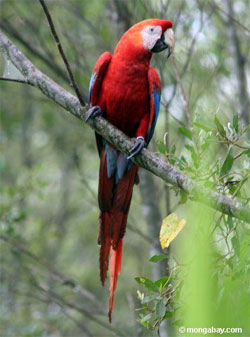Pet trade and habitat loss decimating wild macaw populations
Pet trade and habitat loss decimating wild macaw populations
mongabay.com
October 23, 2006
Macaws, the world’s largest parrots, are declining in the wild due to over-zealous collecting for the pet trade, poaching, and habitat loss according to a researcher at Texas A&M University.
Dr. Don Brightsmith, a bird specialist at Texas A&M University’s Schubot Exotic Bird Center, says that of the world’s 17 species of macaws, one is extinct, another is extinct in the wild, and seven are endangered. All are suffering population declines in the wild.
Brightsmith, who recently traveled to the Amazon rainforest of eastern Peru where he runs a long-term macaw research project, said that beauty is in some ways a curse for macaws.
 Scarlet macaw in Peru. Photo by R. Butler .
|
“[Macaws] are stunningly beautiful birds and have amazingly bright colors,” he said. “You have to admire them for their beauty, which is almost a curse for them and one reason why they are so highly prized. But surprisingly little is known about them — their movements, their habits, their reproduction, almost everything about them. We just don’t know much about these beautiful birds.”
Brightsmith, whose research is underwritten by the Schubot Center, Earthwatch Institute and Rainforest Expeditions, said that while logging and the pet trade are factors behind their decline, one sometimes over-looked threat is demand for Mauritia or Aguaje palm fruit. The Aguaje palm one the macaw’s favorite nesting sites and important food sources.
“Unfortunately, the locals have discovered that the best way to get the fruit is to chop down the whole tree, and these can grow up to 100 feet high,” lamented Brightsmith. “So nesting areas and food sources for macaws are being eliminated.”
For these reasons, says Brightsmith, it is critical that scientists learn more about macaw ecology.
“[We] need to learn more about their breeding habits, their migration routes, more about their diet and many other things,” he added. “The more we learn about these birds, the better our chances to save them.”
This article is based on a news release from Texas A&M University







